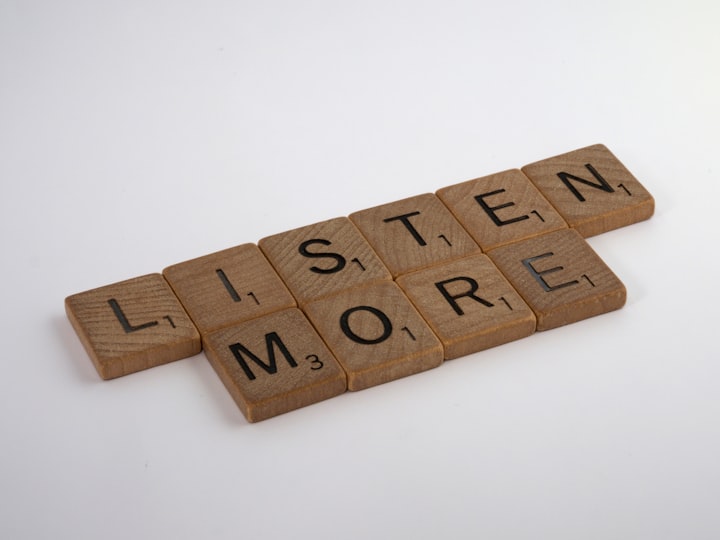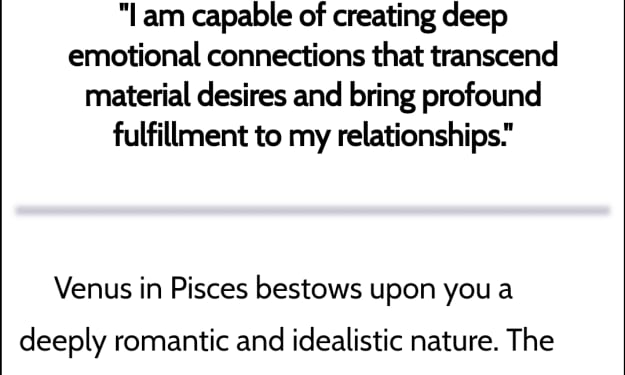Lost Art of Listening
Practice the Art of Mindful Communication for Improved Physical and Mental Well Being

Listen, Listen, Listen, …
This is the most common mantra we all need to practice during our everyday conversations.
This is for all of us …. not just teenagers.
Good listening applies to everyone across all spectrums of life. It does not matter what age, color, health, ethnicity, or other status and in what situation you belong to.
Conversations happen everyday, everywhere. At home, in office, business, restaurants, restaurants, …. and more.
Conversations happen between couples, families, friends, colleagues, supervisors, and strangers.
During one of these conversations, most us fail to listen to the speaker.
Why?
Because our mind is constantly thinking of one thing or the other, even during the conversations. We are not focussed on any one thing.
Not Listening Affects Both Parties
Although we engage very well during our everyday short conversations with friends, families, and colleagues at work, we do not focus and listen during serious conversations with our spouse, partner, or children, or supervisors.
When we do not listen, the speaker also feels neglected and hurt with a feeling of not being heard.
So "not listening" affects both, the listener and the speaker.
Most adults suffer from this habit of not listening. This is not a medical condition. Most people simply do not pay attention to the other person during the conversation.
Listening is Rare
In today's fast-paced, digitally interconnected world, it seems we have lost the ability to listen.
Most of us are always in a rush to do things quickly. As a result, our attention span has reduced.
We hear what others are saying, but we simple do not listen. We often hear things based on perceived impressions and past interactions, and then immediately respond.
As a result we react impulsively rather than respond thoughtfully.
Not paying attention and listening is one of the major problems among lot of adults today.
I was one of those people who would talk over the other person while having a face-to-face conversations, or over the phone.
This lack of mindful communication creates misunderstandings, conflicts, and missed opportunities for genuine connection.
Effective communication has become more critical than ever.
In this article, I will briefly explore the importance of the art of listening, and then outline how we can use this technique to improve our relationships and also lead to better health.
Attentive Listening, the Lost Art
With access to so many electronic devices, we have been subjected to information overload. We are constantly bombarded with messages from various sources - mobile phones, televisions, computer through social media, news outlets, advertisements, and useless conversations.
Amid this constant stream of information, we are trying to remain busy at work, earn money, take care of family, and meet social obligations of meeting with friends and families.
Since we spend more time online through various devices, we have reduced our face-to-face interactions with our friends. As a result, we have reduced practicing our communication skills.
There is less emotional connection.
Humans need emotional connection who can empathize.
This is one of the main reasons why some people feel they are on the edge, or feel insecure, or behave impersonally.
Since the listener is not paying attention to the speaker, the speaker feels frustrated, and perceives that the other person is ignoring or being disrespectful.
This frustration leads to unnecessary arguments and misunderstanding.
That is why it is all the more important to develop an emotional connection with fellow beings through proper communication.
It seems, we have lost the art of listening attentively.
We can always practice this art anytime we want, and recover our communication skills.
How do we develop this art of listening?
Art of listening involves 4 easy steps
- Intently listening by paying full attention to the speaker
- Pausing before responding
- Thinking, which is grasping what the other person has said, and then,
- Responding calmly with a few select words
1. Listening, with attention
Listening is an art.
Not everyone is good at listening, initially.
While growing up during our formative years in schools, we may have observed that while some of us attentively listened to our teachers, others were not so attentive.
We are easily distracted.
Just like everything else in life, the art of 'listening' has to be practiced consciously, and then cultivated in our everyday interactions.
Here is what you can do.
Next time you sit down for a conversation with someone, consciously pay full attention to that person by looking into their eyes. It must be an undivided attention. You do not need to stare into their eyes constantly. Just look at them naturally. Do not look down, or scan your phone, or divert your attention to something else.
If we adopt and practice this art with each person, even for few minutes a day, attentive listening will become second nature.
Conscious practice will build into everyday habit.
If you just execute this step even once, the other person will feel genuinely respected.
They will feel that you truly cared and heard their side of the story.
True listening involves not only hearing the words spoken, but also understanding the underlying emotions and intentions of the speaker.
In future, artificial intelligence system, or the voice recognition system from Google or Amazon can hear us and respond, but they cannot emote or understand emotions.
By actively listening, we can build empathy and foster healthier relationships with others.
2. Power of the pause
In most normal circumstances, we tend to respond quickly because we mostly talk about topics that are familiar to us. Thus, we have the information at hand to respond quickly.
As a result, we have developed a tendency to respond quickly.
But when faced with a difficult conversation or a challenging situation, with our in-built habit, people often tend to rush to respond immediately. This is where most people make the mistake of responding poorly.
What if, … instead of responding immediately to a challenging discussion, …. you were to take a pause, and during that pause, take one deep breath.
What happens if we take a pause and take a deep breath?
Magic happens!
Taking a momentary pause during a difficult discussion can make a huge difference in the way you think and respond.
Pausing allows us to gather our thoughts, process the information received, and control our emotions.
Taking deep breath allows our body to inhale more oxygen. This calms down our thought process, and centers our thinking to the discussion at hand.
In this brief moment, we get two benefits:
- Avoid knee-jerk reactions and
- Respond from a place of clarity and composure.
Try this next time you are in situations where you do not feel comfortable responding. You will notice that pausing allows you to respond with more composure.
3. Think Before Speaking
If we observe, most of our rash responses often stem from not thinking before talking. We do not take the time to think about our words we use and their potential impact.
Pausing allows to gather our thoughts.
Thinking allows us to use the right words before speaking. It also helps us choose the right tone and language, thus preventing unintended harm or offense.
Thinking also allows us to express ourselves more effectively, increasing the chances of our message being heard, understood and appreciated by others.
4. Responding Calmly, Not Reacting Impulsively
Have you noticed that whenever we react impulsively, most of the time it leads to heated arguments or misunderstandings.
On the other hand, when we respond calmly, in most occasions, the other person also responds favorably.
When we respond calmly, it promotes open dialogue and constructive problem-solving.
By responding calmly, even in challenging conversations, we can maintain emotional equilibrium and contribute to more productive interactions.
∞ ∞ ∞ ∞ ∞ ∞ ∞ ∞ ∞ ∞ ∞ ∞ ∞ ∞ ∞ ∞ ∞ ∞ ∞ ∞ ∞ ∞ ∞ ∞ ∞ ∞ ∞ ∞ ∞ ∞ ∞ ∞ ∞
I know what you are thinking.
These 4 easy steps are easier said than done. Is there a simple technique to implement these 4 steps?
Yes, there is. It is called …. Mindfulness. Or more precisely, for being a good listener, we call it ….
Mindful Communication
Practicing Mindful Communication
When we engage in mindful communication, it requires intentional effort.
Try to follow some of the suggestions listed below to incorporate mindful communications during our daily interactions:
1. Practice meditation daily: Just spend 10 minutes sitting quietly in the morning. Close your eyes, take few deep breathes, and then relax. Breathe normally. Let the thoughts roll in. Just observe your thoughts as a third person. Do not interact with your thoughts.
2. Being fully present: When engaging in a conversation, stay in the present. Do not look elsewhere. Just give the speaker your undivided attention. Most of the time we do not even look at the other person while engaging in conversations. Try to minimize distractions, maintain eye contact, and actively listen to what the other is person saying.
3. Acknowledging emotions: Recognize your own emotions as well as the emotions of others. Avoid dismissing or suppressing emotions, instead use them as signals to guide your response.
4. Being Aware of yourself: Breath deeply. This gives a moment to be aware of your breath. In that moment, you also give yourself a moment to gather your thoughts.
5. Choosing words: When you are aware of yourself, we also become more mindful of our language and tone in which we respond.
6. Empathizing with the speaker: This is a tough one to practice. But we can all do it. Try to put yourself in the other person's shoes to better understand their feelings and motivations. This will better enable us to respond with empathy and compassion.
7. Silent acknowledgement: We need not respond to every situation with a statement, or a remark. Acknowledging with silence, and maybe with a facial gesture, also works. Staying silent during the conversation makes that other person feel that you are paying attention and listening.
Practice Listening
In our busy world, where we have little time, practicing mindful communication is even more important.
The ultimate beneficiary of this entire practice is us. It is for our own good, both physical and mental well being.
Just by listening attentively, pausing and thinking, and then responding calmly, can foster a healthier relationships and build empathy.
So folks, …. there you have it. Let us make a conscious effort to prioritize mindful communication in our interactions, both online and offline, and create a more connected, understanding, and better world.
About the Creator
Raghavendra S Rao
Passionate about life, people, animals, nature, and surroundings. Love flying airplanes. Educate everyone in various phases of life. Love technology. Learn new things. Help and contribute time and money to the less fortunate.






Comments
There are no comments for this story
Be the first to respond and start the conversation.